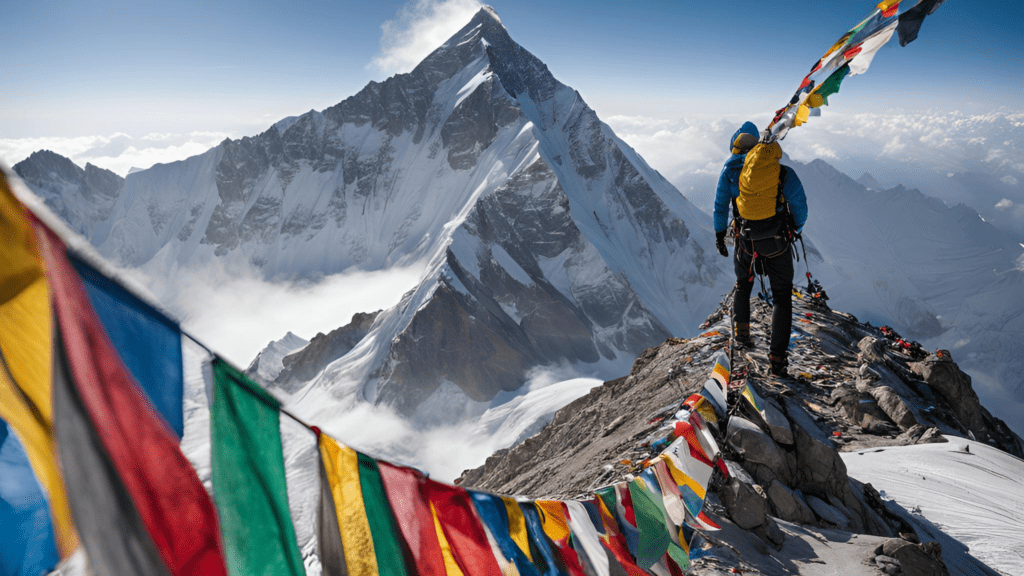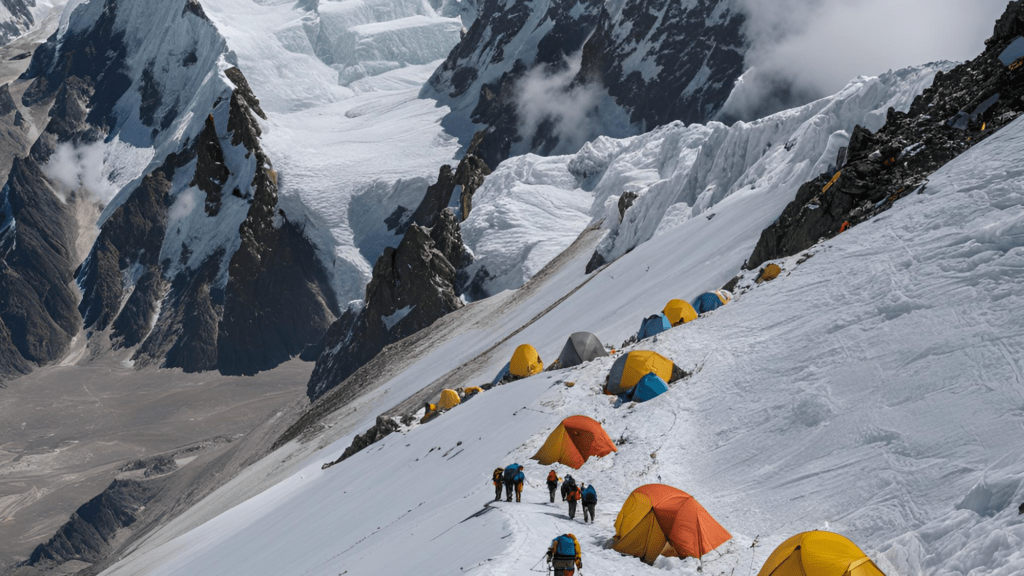Climbing to the summit of Mount Everest, the world’s highest peak at 29,035 feet (8,850 meters), is one of mountaineering’s ultimate achievements. Every year during the Everest climbing season, hundreds of climbers from around the globe attempt to reach the top of this formidable Himalayan giant. If you’re dreaming of your own Everest summit, here’s what you need to know to turn that dream into reality.
Climb Mount Everest
At 8,850m/29,035ft, Mount Everest is the ultimate mountaineering adventure and a life-changing experience to stand at the top of the world. Adventure Consultants, recognized as the premier guiding service with an excellent reputation, pioneered guided ascents on Everest. They invite serious climbers with the right experience, dedication and determination to join their 29th Everest expedition in 2025.

The summit push starts up the South Col route to the Balcony at 8,400m/27,600ft. The challenging summit day involves climbing the exposed ridge between the South Summit and Hillary Step to reach the true summit at 8,850m/29,035ft. This stretch offers some of the best climbing on the mountain along with incredible views.
Climbers use a higher flow of supplemental oxygen than other expeditions for added safety and success – 1L/min while sleeping and 4L/min while climbing. Overnight gear is carried between camps so climbers only carry daypacks.
Training and Prerequisites
Exceptional physical fitness is critical and requires many months of strenuous training tailored to mountaineering. Climbers should be proficient at climbing ice, snow and rock for multiple days in a row. A wide range of skills is ideal, from basic rock climbing to advanced snow and ice techniques. Climbers must be comfortable with camp craft and self-care at high altitudes.
The experience of summiting several 6000-7000m peaks like Denali, Aconcagua, or Himalayan peaks is required. A previous 8000m peak ascent, such as Cho Oyu, is highly recommended to dial in equipment and skills and learn how your body copes with extreme altitude.
After Everest – What’s Next?
For those bitten by the high-altitude bug, you can try climbs on other 8000m peaks like Lhotse, Cho Oyu, Manaslu and more. Combining an Everest and Lhotse ascent on a single expedition is an incredible Himalayan challenge.
The ultimate mountaineering prize is the Explorers Grand Slam – climbing the Seven Summits (the highest peak on each continent) plus skiing to the North and South Poles. Fewer than 70 people have achieved this elite feat, presenting an exciting goal progression after Everest.
When is the Everest Climbing Season?
The Mount Everest climbing season is short – it falls in May each year, when weather conditions are at their best. The jet stream, which brings high winds and cold temperatures, moves away from the mountain in May, providing a window of opportunity for summit attempts.

Most expeditions arrive at Everest Base Camp in late March or April to begin acclimatization rotations on the lower parts of the mountain. Summit pushes are typically made in mid-May. By the end of May, the monsoon season approaches, bringing heavy snowfall and making climbing too dangerous.
Preparing for an Everest Expedition
Climbing Everest is an immense physical and mental challenge that requires meticulous preparation. Most climbers spend 12-18 months focused on:
- Physical training: Building cardiovascular fitness and strength, especially in the legs, core, and back. Endurance is key.
- Mountaineering experience: Everest should not be your first mountain. Climbers need experience on other high-altitude peaks to hone technical skills and understand their bodies’ responses to thin air.
- Gear preparation: Everest requires a plethora of specialized high-altitude gear, from a down suit to a hyperbaric chamber. Obtaining and testing your gear takes time.
- Mental preparation: The mental fortitude required for multiple weeks climbing in the death zone above 26,000 feet cannot be understated. Mental preparation is as important as physical.
Climbing Route Options
Most climbers attempt Everest from one of two main routes:
- Southeast Ridge (Nepal): The most popular route, following the historic line of first ascent. Hazards include the Khumbu Icefall, Lhotse Face, and Hillary Step.
- North Ridge (Tibet): A slightly more technical route with a higher avalanche risk. Avoids the Khumbu Icefall but is colder and windier.
A handful of other routes exist, but are climbed far less frequently due to their difficulty.
Safety Considerations
Safety is paramount on Everest. Key safety considerations include:
- Altitude sickness: Proper acclimatization is essential to avoid potentially fatal high altitude pulmonary or cerebral edema (HAPE/HACE).
- Weather: Storms, high winds, and extreme cold are constant threats. Watching weather forecasts closely is critical.
- Avalanches and icefalls: The Khumbu Icefall is an ever-shifting labyrinth of house-sized ice blocks. Avalanches are common on the Lhotse Face.
- Overcrowding: In recent years, long lines of climbers waiting to ascend/descend have led to dangerous (even fatal) delays in the death zone.
Most expeditions now use supplemental oxygen above 23,000 feet to mitigate the risks of altitude sickness. Having an experienced guide team and Sherpa support also enhances safety.
How Much Does it Cost?
Climbing Mount Everest is an expensive undertaking, with costs ranging from $30,000 to $100,000 or more. Expenses include:
- Travel and transportation
- Permits and fees
- Guide service
- Sherpa support
- Gear and equipment
- Oxygen and medical supplies
- Food and accommodations
Budget expeditions cut corners, while luxury options provide five-star base camp accommodations. Most fall somewhere in between. Cheaper is not always better when your life is on the line.
Is Summiting Everest Right for You?

Standing on the top of the world is an incredible dream – but it takes immense preparation, financial resources, risk tolerance, and mental fortitude to achieve. The Everest summit will always be there. The question is, are you ready for the challenge? With the right preparation and mindset, you can be among the few who get to see the world from its highest point. The choice is yours.
Training and Physical Preparation: Building the Foundation for Success
Climbing Mount Everest demands peak physical fitness and mountaineering experience. Most successful climbers spend 12-18 months in intensive training before attempting the summit. Here’s what you need to focus on:
- Cardiovascular endurance: Build your aerobic base through activities like running, cycling, and swimming. Aim for 1-2 hours of cardio 5-6 days per week.
- Strength training: Focus on leg and core strength with exercises like squats, lunges, and planks. Don’t neglect upper body strength for climbing and carrying gear.
- High-altitude experience: Climb other high-altitude peaks (preferably 6000m+) to acclimatize your body and test your gear.
- Endurance hiking: Practice long hikes (8+ hours) with a heavy pack (50-60 lbs) to simulate Everest conditions.
- Mental preparation: Develop mental toughness through meditation, visualization, and pushing your limits in training.
“The physical challenge of Everest is immense, but the mental challenge is even greater,” says veteran Everest guide Adrian Ballinger. “You have to be prepared to push through extreme discomfort, fear, and doubt for weeks on end.”
Climbing Routes: Choosing Your Path to the Top
There are two main routes to the summit of Everest:
South Col Route (Nepal)
- Most popular route, used by about 75% of climbers
- Follows the path of the first successful ascent by Hillary and Norgay
- Highlights include crossing the treacherous Khumbu Icefall and scaling the Hillary Step
- Generally considered slightly easier technically, but more crowded
Northeast Ridge Route (Tibet)
- Less crowded alternative, gaining popularity in recent years
- Longer approach with drive to base camp, less trekking required
- More exposed to harsh weather, especially high winds
- Technically more challenging, especially the Second Step
“The North side has its own unique challenges,” explains experienced Everest climber Alan Arnette. “The final push to the summit is longer and more exposed, but you avoid the dangers of the Khumbu Icefall. It’s a trade-off each climber has to weigh.”
Essential Gear and Equipment
Choosing the right gear can mean the difference between success and failure – or even life and death – on Everest. Here are some key considerations:
- Down suit: Invest in a top-quality, custom-fitted down suit for extreme cold protection.
- Boots: Choose 8000 m-rated, double-layer boots with integrated gaiters.
- Oxygen system: Most climbers use supplemental oxygen above 23,000 feet. Select a reliable system and practice using it.
- Ice axe and crampons: Essential for moving on steep, icy terrain.
- Harness and carabiners: For clipping into fixed ropes on exposed sections.
“Don’t skimp on gear,” advises Everest summiteer Melissa Arnot. “Your life depends on it functioning in the harshest conditions imaginable.”
Choosing a Guide Service: Your Partners in the Journey
Selecting the right guide service is crucial for a safe and successful Everest expedition. Consider these factors:
- Experience: Look for companies with a long track record of Everest expeditions.
- Safety record: Ask about their safety protocols and emergency procedures.
- Group size: Smaller groups often mean more personalized attention.
- Sherpa support: Experienced Sherpa teams are essential for summit success.
- Acclimatization strategy: Understand their approach to managing altitude.
“A good guide service doesn’t just get you to the top,” says veteran Everest guide Dave Hahn. “They ensure you have the skills and knowledge to climb safely and make smart decisions in extreme conditions.”
The Summit Push: A Climber’s Perspective
As the sun begins to rise, painting the Himalayan peaks in hues of gold and pink, I take my final steps towards the summit of Everest. My breath comes in ragged gasps, each movement a monumental effort in the thin air above 29,000 feet. But as I crest the final ridge and see the small, snow-covered plateau that marks the highest point on Earth, all the exhaustion fades away.
“Standing on the summit of Everest is indescribable,” recounts climber Jim Davidson. “You’re quite literally on top of the world, with the curvature of the Earth visible in every direction. It’s a moment of pure elation and awe that will stay with you for the rest of your life.”
Refer to my article: What is Altitude Sickness? – 5 Best Ways to Stay Fit in Mountain for information on mountain sickness and how to stay fit while in the mountains.
Conclusion: The Call of the Mountain
Summiting Mount Everest is more than just a physical achievement – it’s a transformative journey that pushes you to the very limits of human endurance and willpower. As you stand atop the world’s highest peak, gazing out over the vast expanse of the Himalayas, you’ll be filled with a sense of accomplishment and wonder that few other experiences can match.
But remember, the true spirit of mountaineering lies not just in reaching the summit, but in the journey itself. The friendships forged, the personal growth achieved, and the deeper connection to the natural world are all part of the Everest experience.
So, if you hear the call of the mountain, heed it. With proper preparation, respect for the mountain, and an unwavering spirit, you too can stand on the roof of the world and realize your Everest dreams. Catch My Experiences on YouTube




